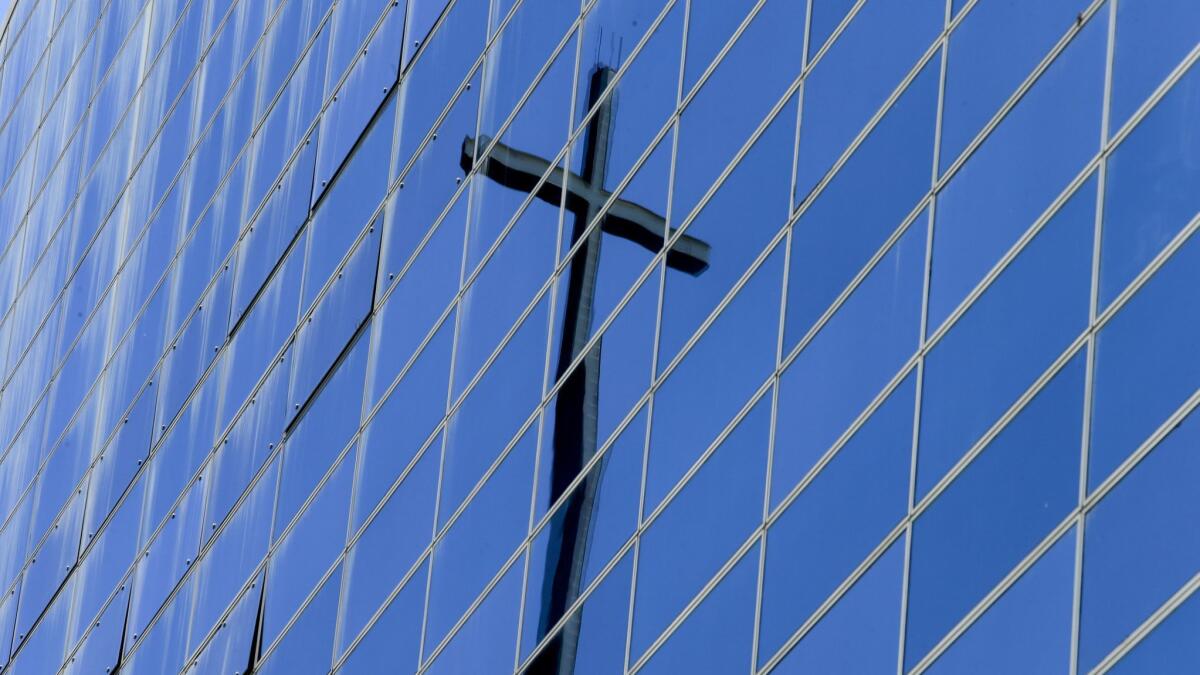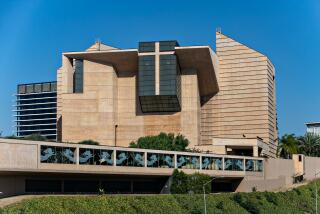Catholic churches move to name molesting priests, but victims say it’s too little, too late

- Share via
Over the last two decades, Roman Catholic dioceses across California have paid out massive settlements to parishioners who say they were molested by priests; acknowledged institutional breakdowns that facilitated abuse; and wrestled with followers who said they had lost faith in church leaders.
Now, after a Pennsylvania grand jury detailed rampant sexual abuse committed by Catholic clergy there, some dioceses have moved toward even greater transparency by releasing the names — in some cases for the first time — of priests accused of such crimes.
San Diego’s diocese updated its public list in mid-September. The Archdiocese of Los Angeles and the Diocese of Orange are reviewing their lists of credibly accused priests — which were last updated in 2008 and 2016, respectively — to see whether any names should be added. And bishops of the San Bernardino and San Jose dioceses say they plan to publish names in the coming weeks.
The decision to disclose has been made across the U.S. — by bishops in places like Youngstown, Ohio; Fort Wayne, Ind.; and Little Rock, Ark. — following the Pennsylvania report that revealed a decades-long cover-up of child sex abuse involving more than 1,000 victims and hundreds of priests.
Attorneys general in at least eight states also have launched investigations into alleged clerical sexual misconduct, requesting or subpoenaing diocese records. California Atty. Gen. Xavier Becerra’s office declined to say whether it had an examination underway.
Increasing pressure on the church, a civil suit was filed Tuesday in Los Angeles County Superior Court on behalf of Tom Emens, who says he was abused decades ago by a Southern California priest. The suit does not seek monetary damages, but calls on 11 California dioceses — all but Stockton’s — to release the names of every clergy member accused of sexual misconduct, as well as private records documenting abuse.
The law firm handling the suit also released a lengthy report that lists 307 clerics associated with the Archdiocese of Los Angeles who have been accused of abuse. Attorneys say at least 36 of the priests are not included in the archdiocese’s official list.
The California Catholic Conference responded to the lawsuit by noting that many of the allegations had been previously revealed and that churches had taken aggressive steps to improve reporting and prevent abuse.
Victims of clergy molestation say that while further disclosures of priest misconduct are a positive step, they are largely symbolic. More needs to be done to address the church’s systemic, decades-long cloaking of abuse, they say.
“It’s like a serial murderer giving the name of five of his 35 victims,” said Joelle Casteix, an expert on clergy sex abuse who said she was assaulted by a choir teacher at the Catholic school Mater Dei High in Santa Ana in the 1980s. The details of her claim were contained in documents released in 2005 by the Diocese of Orange.
Publishing the names of accused priests “doesn’t help survivors. It doesn’t get predators off the streets,” Casteix said. “It doesn’t invoke fear in the hearts of clerics who may still be molesting kids right now.”
Abuse survivors note that many of the named clergy members are dead or no longer live in California. In the San Diego Diocese, five of the eight priests recently added to its public list are deceased.
“Is it going to make the community or parish safer by putting out these names?” said Thomas Plante, a psychology professor at Santa Clara University who treats church victims and abusers. “I don’t know if it does, frankly.”
But in the absence of a statewide investigation, say some who identify as clerical abuse survivors, the disclosures are a start.
Jaime Romo is one of them.
Now a minister who provides trauma services at Pilgrim United Church of Christ in Carlsbad, Romo says he was molested by an L.A. pastor when he was 14.
Victims often feel a double betrayal, he said — first by their abuser, and then by the church when it hides the abuse. So releasing priests’ names can alleviate some pain wrought by decades of clerical negligence, Romo said.
Likewise, the disclosures may provide solace to those who may have never told anyone about their abuse, said Carlos Perez-Carrillo, a former altar boy who says he was molested by a priest at St. Bernard High School in Playa del Rey.
“There will be people out there that will see a perpetrator’s name and say, ‘Now I feel fine coming forward because I can say what happened to me happened to other people,’” Perez-Carrillo said. “It’s validating.”
Because of the church’s once-pervasive practice of reassigning accused clerics rather than removing them from ministry completely, it is difficult — if not impossible — to know the full extent of the national web of abuse, said Massimo Faggioli, a professor of historical theology at Villanova University in Pennsylvania.
Even the 900-page Pennsylvania grand jury report paints a partial picture, Faggioli said, because some of those priests were sent to the West Coast, “and we don’t know what these dioceses in the West have on these priests.”
Given the church’s power structure — local bishops have almost total control in their districts — it is unlikely that national leadership will order a release of names across the U.S., Faggioli said. But it’s a good sign that the latest disclosures are happening at a faster clip than in 2002, when the Catholic Church’s sex abuse scandals were first exposed by the Boston Globe, he said.
Even so, dioceses’ self-reporting has previously proved to be incomplete.
In 2006, a Times analysis found that the Archdiocese of Los Angeles partially or completely omitted 11 known cases of clerical abuse from its “Report to the People of God.” This was after then-Archbishop Roger Mahony said the report provided the “fullest possible disclosure” of how the church responded to sex abuse allegations.
And San Diego’s list of accused priests from decades past may grow; administrators are still reviewing files, diocesan spokesman Kevin Eckery said.
“I would love to say that the process is a well-oiled machine,” Eckery said. “But one of the things we found in putting the list together is how complicated it is to review these records.”
Issues of partial transparency and disorganized investigations show why churches should turn over every known record of alleged abuse to the attorney general for independent review, victims’ advocates in California say.
“Every bishop … needs to open their files and say, ‘Here you go. Here’s the evidence,’” Casteix said.
In a statement to The Times, the L.A. Archdiocese said it stopped adding names to its People of God report after 2008 because parishes and schools were announcing instances of abuse as they were discovered. The report, church leaders said, is now being updated and the names of priests who have abused minors in the years since will be published when that process is complete.
To Casteix, that is a halfhearted response to decades of trauma inflicted on the church’s most vulnerable parishioners.
“We’re seeing this slow drip of names, more and more promises of transparency,” she said. “But the policies and patterns that enabled this abuse are still in place.”
[email protected] | Twitter: @LauraMNewberry
More to Read
Sign up for Essential California
The most important California stories and recommendations in your inbox every morning.
You may occasionally receive promotional content from the Los Angeles Times.











